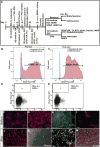Human neural progenitors derived from integration-free iPSCs for SCI therapy
- PMID: 28073086
- PMCID: PMC5629634
- DOI: 10.1016/j.scr.2017.01.004
Human neural progenitors derived from integration-free iPSCs for SCI therapy
Abstract
As a potentially unlimited autologous cell source, patient induced pluripotent stem cells (iPSCs) provide great capability for tissue regeneration, particularly in spinal cord injury (SCI). However, despite significant progress made in translation of iPSC-derived neural progenitor cells (NPCs) to clinical settings, a few hurdles remain. Among them, non-invasive approach to obtain source cells in a timely manner, safer integration-free delivery of reprogramming factors, and purification of NPCs before transplantation are top priorities to overcome. In this study, we developed a safe and cost-effective pipeline to generate clinically relevant NPCs. We first isolated cells from patients' urine and reprogrammed them into iPSCs by non-integrating Sendai viral vectors, and carried out experiments on neural differentiation. NPCs were purified by A2B5, an antibody specifically recognizing a glycoganglioside on the cell surface of neural lineage cells, via fluorescence activated cell sorting. Upon further in vitro induction, NPCs were able to give rise to neurons, oligodendrocytes and astrocytes. To test the functionality of the A2B5+ NPCs, we grafted them into the contused mouse thoracic spinal cord. Eight weeks after transplantation, the grafted cells survived, integrated into the injured spinal cord, and differentiated into neurons and glia. Our specific focus on cell source, reprogramming, differentiation and purification method purposely addresses timing and safety issues of transplantation to SCI models. It is our belief that this work takes one step closer on using human iPSC derivatives to SCI clinical settings.
Keywords: Neural repair; Neuroprotection; Spinal cord injury; iPSC.
Copyright © 2017 The Authors. Published by Elsevier B.V. All rights reserved.
Figures





References
-
- Ban H, Nishishita N, Fusaki N, Tabata T, Saeki K, Shikamura M, Takada N, Inoue M, Hasegawa M, Kawamata S, Nishikawa S. Efficient generation of transgene-free human induced pluripotent stem cells (iPSCs) by temperature-sensitive Sendai virus vectors. Proc Natl Acad Sci U S A. 2011;108:14234–14239. - PMC - PubMed
Publication types
MeSH terms
Substances
Grants and funding
LinkOut - more resources
Full Text Sources
Other Literature Sources
Medical
Research Materials

